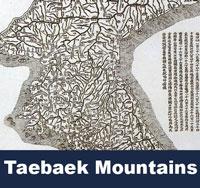Taekwondo 태권도Taekwondo Preschool
When you reach senior belt you are expected to guide the junior belts when they are beginning Taekwondo such as showing by example. To advance from one rank to the next, students typically complete promotion tests in which they demonstrate their proficiency in the various aspects of the art before a panel of judges or their teacher. View Taekwondo belt levels »

Taebaek Mountains 태백산맥
The Taebaek Mountains are a mountain range in stretches across North Korea and South Korea. They form the main ridge of the Korean peninsula.
Geography
The Taebaek mountains are located along the eastern edge of the peninsula and run along the eastern coast of Korean Peninsula. The Mt. Hwangnyong Mountain in North Korea (1268 meters) forms the northern end of the range. Busan lies at the southern end of the mountain range. This makes the mountain range a total length of over 500 kilometers, averaging about 1000 meters in height.
Prominent peaks of the range include Mount Seoraksan (1,708 m), Mount Kumgangsan (1,638 m), Mount Taebaeksan (1,566.7 m) and Mount Odaesan (1,563 m). To the east, the mountain range falls steeply into the sea, but to the west, there are more gentle slopes. Many spurs stretch southwest. The most important rivers of South Korea, the Han River and the Nakdong River, both originate in the Taebaek Mountains.
Ecology
Many of the slopes are extensively covered in forests.
Industry
Economically the Taebaek mountains are important for the mining of iron, coal, tungsten, and limestone.
Attractions
Manggyeongsa Temple in Hyeol-dong Taebaek, Yeongwol-gun County, Gangwon-do Province at an altitude of 1,460 meters on Mount Taebaeksan, is a temple built to enshrine the statue of the Bodhisattva of wisdom. It was built by Jajang, a Silla Dynasty monk. The "Dragon Spring" at the entrance of the temple is known as the highest spring in Korea.
The 2018 Winter Olympics took place in Pyeongchang, Gangwon-do, located in the mountains.
There are five tenets defined in the International Taekwondo Federation (ITF) and several more in World Taekwondo (WT).
Integrity ( 염치 yeom-chi ): "Although it may be similar, this form of integrity takes on a more wider role then defined in the common dictionary. In taekwondo, integrity means not only to determine what is right or wrong but also having the conscience to feel guilt if one has done wrong and to have the integrity stand up for what is right." View Taekwondo Tenets »
Promotion from one dan to the next can take years. The general rule is that a black belt may advance from one rank to the next only after the number of years equivalent to the current rank. For example, a newly promoted third-degree black belt may not be allowed to advance to fourth-degree until three years have passed. View more information on Black Belt Dan ( 단 ) ».
RESOURCES
This article uses material from the Wikipedia article "Taebaek Mountains", which is released under the Creative Commons Attribution-Share-Alike License 3.0.











